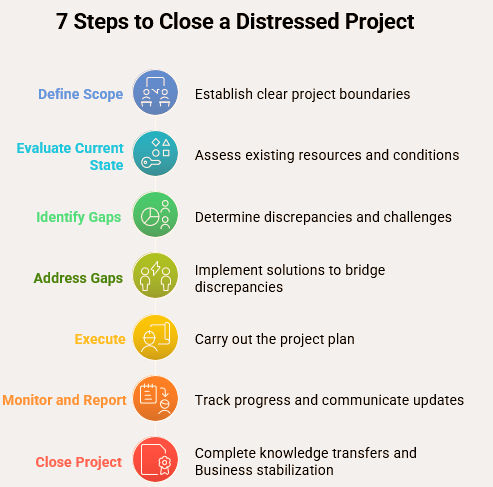Turning the Tide: An Introduction to Closing Distressed Projects with Confidence
- Justin M
- Jul 9
- 3 min read
Updated: Jul 14

You’ve likely been there, stepping into a vortex of frustration, tension, and stalled progress, handed a project that feels like climbing an insurmountable mountain. The dreaded distressed project. The weight of expectations can be heavy, and without the right approach, it’s easy to be consumed or worse, positioned as the scapegoat.
To navigate this effectively, you need to recognize that not all problems are equal. There’s a hierarchy, and how you tackle them should depend on where the project is in its lifecycle.
Here’s a snapshot of what you’ll often inherit when stepping into a distressed project:
Unclear or undefined scope
Solution design or implementation misaligned with business needs
Low team morale
Growing stakeholder frustration
Escalating project costs
Repeated missed deadlines
Operational disruptions impacting the business
Vendor standoffs and commercial disputes
Obscure or unreliable status reports
Ineffective or unfocused escalations
Sounds like fun huh?
The problem is that there is so much to do within such a short period of time. The tensions are rising, and the tolerance for mediocrity and missteps is down to zero. As a project manager stepping into this environment, securing quick wins is essential, not just for optics but to rebuild morale. Without early progress, you risk inheriting the accumulated frustration from previous missteps or the shortcomings of your predecessor.
💡PRO TIP: Resist the urge to critique the previous project manager(s). Your priority is to bring the project to completion, not to fixate on the past. You likely don’t have full context, and early judgments can come across as blame-shifting or tone-deaf. Instead, stay grounded in facts, seek clarity where needed, and demonstrate reliability through your follow-through.
Now, is there a universal template for rescuing troubled projects?
No, not one that works in every situation.
But through experience, we’ve developed a dynamic yet practical seven-step approach. Are these steps simple? Not quite. You’ll likely face tough conversations, high-pressure moments, and the occasional late night just to get oriented. But if you follow these guidelines with intention, you’ll find steady ground and make meaningful progress, one step at a time.

Seven Steps at a Glance
1. Define Scope: Clarify what the project is and isn’t delivering. Align with all key stakeholders, then document and formalize the scope to create a clear standard for success.
2. Evaluate the Current State: Quickly assess the project’s status across strategy, governance, planning, communication, solution design, and team morale. Focus on identifying what’s actively blocking progress.
3. Identify Gaps: Pinpoint what’s missing, broken, or unclear, whether it’s outdated plans, undefined roles, missing requirements, or team dysfunction. Prioritize the gaps that threaten stability.
4. Address Gaps: Tackle the highest-priority issues first. Collaborate with stakeholders to reestablish clarity, rebuild plans, restore accountability, and re-engage the team.
5. Execute: Push forward with focus, despite chaos and competing demands. Stay aligned to business value, manage noise from stakeholders, and protect the team’s ability to deliver.
6. Monitor & Report: Keep stakeholders informed through clear, timely, and transparent reporting. Use dashboards, meetings, and summaries tailored to different audiences to maintain alignment and trust.
7. Close Project: Ensure the business is stable, documentation is complete, and support is transitioned. A successful close means the team can operate independently without your continued involvement.
Turning around a distressed project isn’t about heroics; it’s about discipline, judgment, and strategic focus. You won’t fix everything overnight, and you won’t please everyone along the way. But by grounding your actions in clarity, prioritization, and collaboration, you can transform chaos into momentum. These seven steps aren’t a magic formula; they’re a pragmatic framework to help you stabilize, deliver, and, ultimately, close with confidence. Stay focused, stay intentional, and remember: progress is built one decisive step at a time.
🎯Up next: we’ll break down Step 1: how to define scope when it’s vague, missing, or politically charged. We’ll cover practical ways to surface misalignments early, ask the right questions, and build agreement without endless meetings or circular debates.
--
Pragintion PM, we specialize in navigating ambiguity and high-stakes environments tied to complex initiatives.
Our program & project management services are grounded in a pragmatic, intentional approach delivered through a client-validated methodology that gets results.
Found this article helpful?
✅ Share it with your network
📌 Save it for future reference
Follow Pragintion PM for more insights on driving real business value from complex programs and projects.

- J&A TBC LLC 2025©

